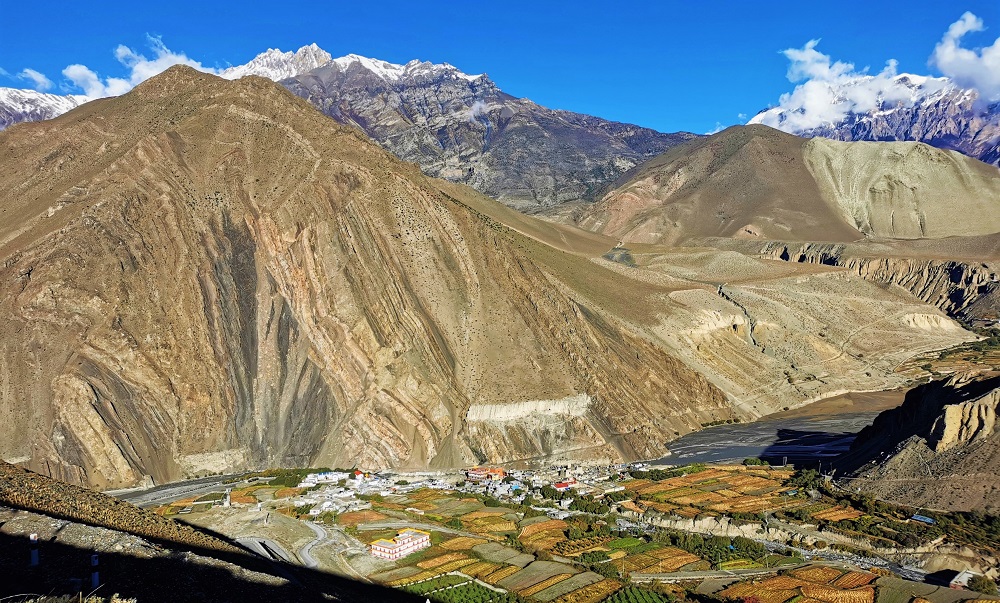Interesting things about Kagbeni village | All you need to know about Kagbeni in Mustang
Kagbeni is a quaint village located in the Mustang district of Nepal, nestled in the picturesque Kali Gandaki River Valley. Situated at an altitude of approximately 2,800 meters (9,186 feet), Kagbeni holds significant cultural, historical, and religious importance. It serves as a gateway to the mystical Upper Mustang region and offers a captivating glimpse into the ancient Trans-Himalayan trade route between Nepal and Tibet.
The village of Kagbeni is known for its unique architecture and traditional mud-brick houses. The buildings in Kagbeni are closely clustered together, creating a labyrinth of narrow alleyways and stone-paved streets. The architectural style reflects the influence of Tibetan culture, with flat roofs, white-washed walls, and intricate wood and stone carvings. The village has a timeless charm, and wandering through its narrow lanes gives visitors a sense of stepping back in time.
One of the prominent landmarks in Kagbeni is the Kagbeni Monastery, also known as the Red Gompa. This ancient monastery, believed to date back several centuries, holds great religious and cultural significance. The monastery features beautiful Buddhist murals, statues of deities, and prayer wheels. Inside the monastery, visitors can witness daily prayers, experience the meditative atmosphere, and gain insight into the Buddhist traditions practiced in the region.
Kagbeni's strategic location on the Annapurna Circuit trekking route makes it a popular stopover for trekkers. It serves as a checkpoint for trekkers heading towards the restricted Upper Mustang region, known for its unique landscapes, ancient cave dwellings, and preserved Tibetan Buddhist culture. The trek from Kagbeni to Upper Mustang offers breathtaking views of the surrounding Himalayan peaks, including Nilgiri, Dhaulagiri, and Annapurna. It takes trekkers through arid and desert-like terrain, crossing suspension bridges over the Kali Gandaki River, and passing through remote villages that offer glimpses into the local way of life.
Kagbeni also has historical significance as a major trading hub along the ancient salt route between Nepal and Tibet. The village served as a crucial checkpoint for traders and pilgrims traveling between the two regions. Remnants of its trading heritage can still be seen, including the old salt depot and the medieval fortress that once protected the village. Exploring these historical remnants gives visitors a glimpse into Kagbeni's past as a vibrant trading center.
The Kali Gandaki River, which flows through Kagbeni, adds to the natural beauty of the area. The river has carved the deepest gorge in the world, the Kali Gandaki Gorge, and offers stunning views of the surrounding Himalayan peaks. Travelers can enjoy peaceful walks along the riverbanks, marvel at the towering cliffs, and experience the tranquility of the river's flow.
Kagbeni is also the starting point for the trek to Muktinath Temple, a revered pilgrimage site for both Hindus and Buddhists. Muktinath Temple, located approximately 3,800 meters (12,467 feet) above sea level, is known for its sacred shrines, natural springs, and the eternal flame that continuously burns. Pilgrims from different parts of Nepal and beyond visit the temple to seek blessings, cleanse themselves in the holy water, and experience the spiritual atmosphere of the place.
In summary, Kagbeni is a captivating village that offers a blend of history, culture, spirituality, and natural beauty. Its unique architecture, ancient monastery, connection to the Trans-Himalayan trade route, proximity to the Upper Mustang region, and association with the Annapurna Circuit make it a remarkable destination for trekkers, history enthusiasts, and those seeking an authentic Himalayan experience.




.jpg)



